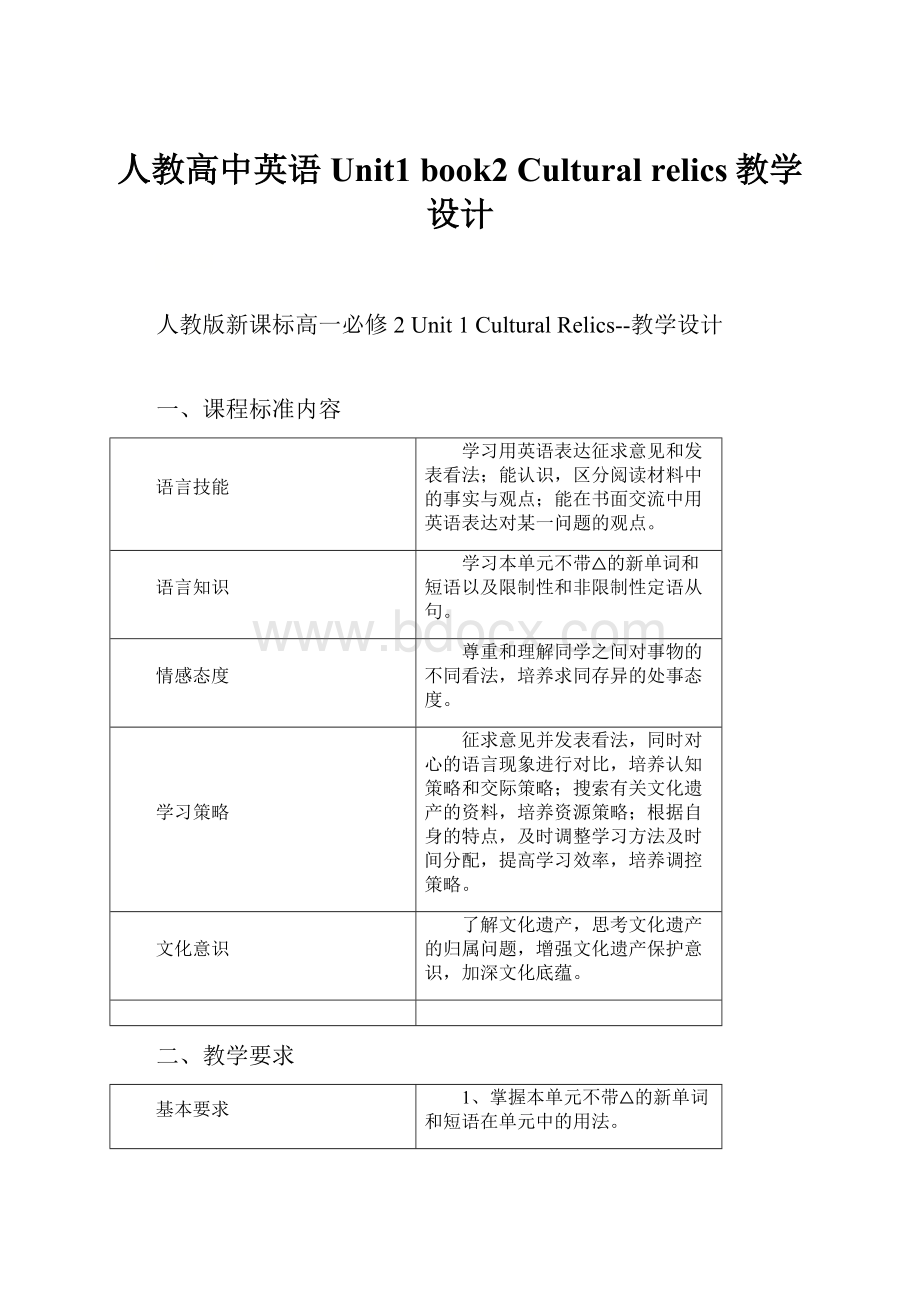人教高中英语 Unit1 book2 Cultural relics教学设计.docx
《人教高中英语 Unit1 book2 Cultural relics教学设计.docx》由会员分享,可在线阅读,更多相关《人教高中英语 Unit1 book2 Cultural relics教学设计.docx(18页珍藏版)》请在冰豆网上搜索。

人教高中英语Unit1book2Culturalrelics教学设计
人教版新课标高一必修2Unit1CulturalRelics--教学设计
一、课程标准内容
语言技能
学习用英语表达征求意见和发表看法;能认识,区分阅读材料中的事实与观点;能在书面交流中用英语表达对某一问题的观点。
语言知识
学习本单元不带△的新单词和短语以及限制性和非限制性定语从句。
情感态度
尊重和理解同学之间对事物的不同看法,培养求同存异的处事态度。
学习策略
征求意见并发表看法,同时对心的语言现象进行对比,培养认知策略和交际策略;搜索有关文化遗产的资料,培养资源策略;根据自身的特点,及时调整学习方法及时间分配,提高学习效率,培养调控策略。
文化意识
了解文化遗产,思考文化遗产的归属问题,增强文化遗产保护意识,加深文化底蕴。
二、教学要求
基本要求
1、掌握本单元不带△的新单词和短语在单元中的用法。
2、巩固限制性定语从句,识别和初步掌握非限制性定语从句的用法。
3、能比较清楚地表达自己的观点,并就具体事物发表自己的看法。
发展要求
1、思考如何保护文化遗产,并展开讨论。
2、探究文化遗产对人类文明历史发展的作用。
说明
非限制性定语从句要与限制性定语进行对比;在理解的基础上逐步掌握非限制性定语从句,不能要求一步到位。
三、课时分配
第一课时:
阅读课Warmingup;Pre-reading;Reading;
第二课时:
阅读课和语言点学习Reading;Learningaboutlanguage;
第三课时:
语法课及阅读课复习Grammar;RevisionofReading;
第四课时:
复习课RevisionofAttributiveclauses;RevisionofReading
第五课时:
阅读课及复习课Usinglanguage—afactoranopinion;Revisionofattributiveclauses
第六课时:
读听课Reading—BigFengtotheRescueP45;ListeningofLearningEnglish;
第七课时:
练习巩固课LearningEnglish;校本练习;单词测试。
四、教学过程设计
第一课时:
阅读课Warmingup;Pre-reading;Reading;
(INSEARCHOFTHEAMBERROOM)
Aims:
Aftertheclass,theSswillbeableto
1.readandlearnaboutculturalrelics:
definition,characteristics
2.learnaboutthestoriesoftheamberroombyscanning,skimmingandcarefulreading
3.learnsomewordsaboutculturalrelicsbyclassification
4.retellthestoryoftheamberroomintheSs’ownwords
I.Warmingup
1.AsktheSstoenjoy3groupsofpicturesandtalkaboutwhichplacetheywanttovisitmost.
TheSsshouldshowtheirreasons.
(列举3组文化遗产的画,让学生对学习本文产生兴趣,并逐渐与本课话题关联,并引出下面的话题)
2.AsktheSstotalkaboutthedefinitionofaculturalrelic.
(让学生自己阐述文化遗产的概念,试探学生对文化遗产的理解,再是老师给出相关概念,让学生在对比中学习)
3.AsktheSstonamesomeotherculturalrelicsathomeandabroad.
(这一步是对上面文化遗产认识的延伸和运用,查看学生是否已经对文化遗产有了大致了解)
4.AsktheSstodiscussthefollowingquestions:
Howwouldyoufeelifitgotlost?
Why?
Ifyoufindaculturalrelic,whatwillyoudowithit?
(通过上述问题的讨论,培养学生对文化遗产的热爱)
5.AsktheSstotalkabout:
Howshouldwetreatculturalrelics?
(树立学生保护所剩文化遗产的意识)
Reading
1.Pre-reading
1).AsktheSstogetfamiliarwithamberandtheamberroom.
2)AsktheSstoanswerthethreequestionswiththehelpofthewordslist.
(学生大致了解琥珀;借助词汇表,按要求回答问题,让学生接触课文所涉及词汇,扫除学生学习本文的词汇障碍,同时也避免学生学习课文时查阅生词表,从而浪费时间)
2.Fastreading
1)AsktheSstotalkaboutThecharacteristicsofthepassage.
(本文是叙事性说明文,通过填词练习,让学生认识文体特点)
2)AsktheSstofinishEx.2onP2andthenanswerthequestionstofurtherlearnaboutthepassage.
3)AsktheSstofillintheblankstogetthegeneralideaforeachparagraph.
(上述2步是阅读技巧训练题,也是学生阅读中的难点和重点。
前一步为后一步服务,降低学生提取主旨大意的难度)
3.Carefulreading
1)AsktheSstoreadthepassageandfinishEx.1onP2
(了解琥珀屋的历史是本文的重点和难点,借助书上练习,降低学生阅读难度,并为下一步深入阅读作铺垫。
通过填表让学生学会根据时间、人物等关键词快速确定主要信息;通过仔细阅读和分析课文重点内容培养学生的分析能力,同时也使他们进一步理解琥珀屋作为文化遗产的理由。
)
2)AsktheSstotalkaboutwhathappenedtotheamberroomwiththehelpofthetable.Andtrytoretellitwiththehelpoftheyearsandkeywordsmentionedinthetable.
(进一步了解琥珀屋的历史,并能告知同学。
通过复述检查学生对文章大意的了解程度,并检测学生归纳总结和口语表达能力。
)
4.Postreading
AsktheSstodiscussthequestionofEx3onP2.
(本步骤是拓展性思维训练,是小组活动,希望学生运用老师提供的句型和短语,发表观点,培养学生能比较清楚地表达自己的观点,并就具体事物发表自己的看法。
请学生四人一组讨论问题,每小组确定一个组长、一个记录员和一个发言人。
组长组织并参与讨论,记录员记录大家的看法,发言人代表小组陈述大家的看法;讨论后教师请持不同观点的小组分别阐述理由,其他持相同观点的小组补充。
观点没有对错之分,但要言之有理,有充分的论据支持自己的观点。
讨论时可以参考PPT中的一些表达法。
)
Homework
Section
Ex.1P3
第二课时:
阅读课和语言点学习Reading;Learningaboutlanguage;
Aims:
Aftertheclass,theSswillbeableto
1.learnthelanguagesofthepassage;
2.gooverthemainideaandsomeofthelanguagepointsforthepassage;
Ex.checking
CheckSectionVwiththeSs
(阅读和完形训练,常规做法)
Languagepoints
ReadthroughthepassagewiththeSsandpointoutthekeywordsmentionedinthewordlistandusefulphrasesandsentences.
Paymoreattentiontothefollowingwordsandphrases:
rare,valuable,survive,amaze(amazing),select,design,fancy,style,decorate,jewel,reception,doubt,former,worth.
Insearchof,belongto,inreturn,atwar
(通过强调上述语言点及必要时给出例句,要求学生能掌握。
)
Passagerevision
AsktheSstofillintheblanksaboutthesummaryofthepassage.
(进一步巩固和复习所学有关琥珀屋的故事和语言点,初步能运用所涉及的语言点)
Previewworkchecking
CheckthepreviewworkwiththeSs.
(讲解预习卷,强调语言点学习中疏漏的点。
)
Learningaboutlanguage
AsktheSstofinishtheExonP3andchecktheanswers.
(进一步巩固相关语言点)
Homework
Writeasummaryforthepassageandretellit.
LearningEnglishPart1
Findoutalltheattributiveclausesfromthepassage.
Adictationforthereadingpassage
第三课时:
语法课及阅读课复习Grammar;RevisionofReading;
Aims:
Aftertheclass,theSswillbeableto
1.retellthestoryoftheamberroom;
2.gooverthelanguagepointsofthepassage;
3.comparetherestrictiveandnon-restrictiveattributiveclausesandlearntousethem.
Dictation
GivetheSsadictationforthereadingpassage.
(通过听写,督促学生再次复习有关课文的语言点以及重点词汇,词组和重要语句)
Retellingthestoryoftheamberroom
AsktheSstoretellthestoryoftheamberroom.
(老师花10分钟左右时间让学生复述有关琥珀屋故事,注意学生在复述时应以时间为线索,并注意上下文衔接)
Ⅲ:
Discoveringusefulstructures.
1.Jointhepairsofsentencesusingattributiveclausesbyblankfilling.
2.Comparerestrictiveandnon-restrictiveattributiveclausesthroughanexample.
3.Underlineallthesentenceswithattributiveclausesinthetextandtellthe
non-restrictiveattributiveclausesfromtherestrictiveattributiveclauses.
(Independentworkandpairwork)
4.Jointhepairsofsentencesusingrestrictiveornon-restrictiveattributiveclausesby
Exercise2onpage4.(Pairwork)
5.Completethesentencesusingrestrictiveornon-restrictiveattributiveclausesby
Exercise3onpage4.(Groupwork)
6.Makesentencesusingrestrictiveornon-restrictiveattributiveclausestodescribe
thepicturesonthescreenandletothersguesswhattheyaretalkingabout.
(Independentworkandgroupwork)
(设计意图:
1.通过图片创设情境,全班一起复习已经学过的限制性定语从句。
2.继续通过图片引出非限制性定语从句,比较限制性和非限制性定语从句的异同。
3.在课文中找出所有的定语从句,并区分限制性和非限制性定语从句;先独立作业提高课堂效率,再双人作业进行核对与补充。
4.双人作业,使用限制性或非限制性定语从句将两句话合并成一句话,选择合适的关系代词或副词,并确定语序;选择第1,3和5句话进行操练,掌握who/that,why和when引导的定语从句。
5.小组活动,在横线上填写定语从句,将句子补充完整;可以让组长把讨论的结果写在黑板上,在全班进行交流;选择第1,3和4句话进行操练,掌握whose/who/that/whom,which/that和where/which/that引导的定语从句。
6.先独立作业,选择一幅图片,对其用一个完整的句子进行描述,用上定语从句,全班猜测所讲的是哪幅图片;再小组活动,与组员进行猜谜游戏,并分享所写的句子。
)
Ⅳ:
Homework.
FinishthesentencesleftinExercise3and4onpage4.
定语从句分类练习1-38
Section
第四课时:
复习课RevisionofAttributiveclauses;RevisionofReading
Aims:
Aftertheclass,theSswillbeableto
1.furthergooverthelanguageofthereadingpassage;
2.trytosolvetheproblemsoftheEx.ofattributiveclauses
SectionII
GivetheSstheanswersofSectionII
(核对练习,进一步巩固课文的语言点)
II定语从句分类练习
GivetheSstheanswersoftheEx.andgivesomeexplanationwheretheSsthinktheyhavedifficulty.
(定语从句典型题专练,题目有代表性,讲解要到位。
)
IIIhomework
定语从句易混点对比专练
LearningEnglish–Clozeandreading
第五课时:
阅读课及复习课Usinglanguage—afactoranopinion;Revisionofattributiveclauses
Aims:
Aftertheclass,theSswillbeableto
1.learnaboutthedifferencebetweenafactandanopinion;
2.solvemostoftheproblemsoftheEx.oftheattributiveclauses;
I.Reading----AFactoranOpinion
1.AsktheSstoreadthepassageonP5quicklyandanswerthefollowingquestions:
1).Whatisafact?
Afactisanythingthatcanbeproved.
2).Whatisanopinion?
Anopinioniswhatsomeonebelievesistruebuthasnotbeenproved.
3).Whatisanevidence?
Anevidenceistrueinformationwhichmustbefactsratherthanopinions.
(快速阅读,弄清三个定义,便于下一步活动的开展)
2.Workinpairsanddecidewhetherthefollowingsentencesarefactsoropinions.Giveyourreasons.
1.AVWPassatcangofasterthan100kmsanhour.
2.Ithinkit’sthebestcarforafamily.
3.Ithinkdrivingacariswrongbecauseitcausesdamagetotheenvironment.
4.Idon’tlikepublictransportbecauseit’ssocrowded.
5.MorecountriesthaneverbeforewillbecomingtotakepartintheOlympicGames.
6.ItwillbeveryhotwhentheOlympicGamesarebeingheld.
Key:
fact(1,5,6);opinion(2,3,4)
(此步骤便于检查学生是否对上述3个定义是否已经掌握)
3.GivetheSsSomelanguagecluestohelpidentifyfactsandopinions.
4.AsktheSstofinishPart2onP5.
(通过找读关键词和相同问题快速搜寻所需信息;通过做相关练习,巩固区分事实与观点的方法,并学会灵活运用。
)
IIEx.checking
ChecktheEx.ofattributiveclauses
IIILearningEnglish.
Checktheanswers.
Homework
SectionIII
LearningEnglish剩余部分
第六课时:
读听课Reading—BigFengtotheRescueP45;ListeningofLearningEnglish;
Aims
Aftertheclass,theSswillbeableto
1.gooverthelanguagepointsoftheunit;
2.getthemainideaofthereading;
3.furtherunderstandthepassagebysolvingthequestionsinPart2.
I.SectionIII
ChecktheanswerswiththeSs.
II.BigFengtotheRescueP45
1.AsktheSstofinishEx.1
(训练学生主旨大意的提取,学会区分3个选项)
2.AsktheSstoanswerthequestionsofEx.2
(通过问题回答,进一步理解文章大意和细节问题)
3.Pointoutthelanguagepointsfromthepassage.
IIIEx.checking
CheckLearningEnglishanddothelistening.
Homework
Wordtest
SectionVI
第七课时:
练习巩固课LearningEnglish;校本练习;单词测试。
Aims
TheSswillbeabletoconsolidatewhattheyhavelearned
IWordtest
IILearningEnglish
IIISectionVI
Backgroundinformationonculturerelics
I.Whatisaculturerelic?
何谓“文化遗产”?
Culturalrelicsarephysicalremindersofwhatdifferentpeoplesvaluedinthepastandcontinuetovaluenow.Withouttheserelics,wecouldnotcherishculturaltraditionsasmuchorappreciatethelivesofthepeoplewhopracticedthosetraditions.Althoughwemaynotoftenconsiderit,culturalrelicsarenotonlythepossessionofoneculture.Inalargersense,itcanbesaidthattheybelongtoallpeoples.Forthesereasons,thisunitdescribesculturalr